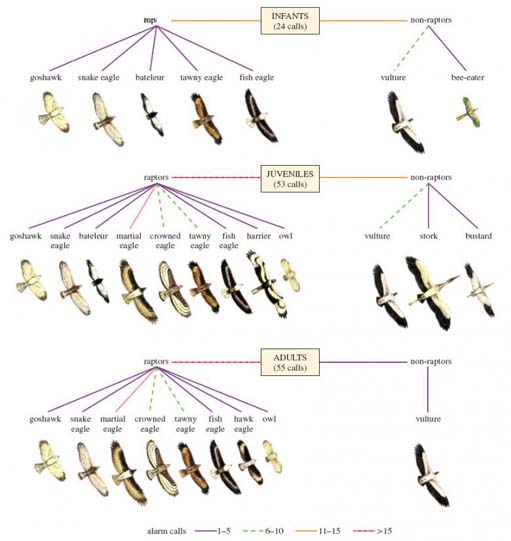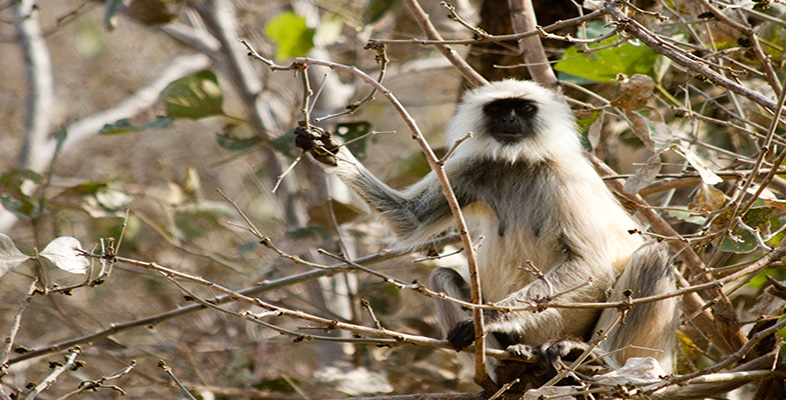3.5.2 Vocal communication
In order to be able to state that animals are communicating vocally with one another, scientists need to demonstrate that particular sounds made by one individual can be understood and acted upon by others.
Activity 5
You will be already aware that vervet monkeys make alarm calls in response to predators [p. 271]; as you saw in the TV programme, other species of monkey do this too. Watch the programme carefully from 26.02-30.30 and make comprehensive notes. You will also need these notes later. Write a few sentences to describe the monkeys' response to alarm calls.
Answer
The monkeys make specific calls in response to each predator. These calls are understood by other individuals, whose evoked behaviour reflects the nature of the threat. For example, on hearing the call reporting the sighting of an eagle, monkeys drop to the ground; on hearing the 'leopard' call, monkeys congregate near the 'caller', thus preventing the leopard from ambushing any isolated individual; on hearing a call indicating the presence of a snake, monkeys on the ground leap for the trees.
Question 8
Think of a way to test that the actions of the group are in response to a call and not to the actual presence of the predator. State the hypothesis that you will be testing.
Answer
One method is to use playback experiments. The alarm calls made in response to each type of predator (eagle, leopard and snake) are recorded. Each call is then played back in turn to the group, in the absence of any predators, using hidden speakers. The hypothesis being tested is: 'Each kind of alarm call alerts the group to the presence of a specific predator'.
Question 9
What do you predict would happen if this hypothesis was correct?
Answer
The group would respond to the recorded call as though an individual could actually see the predator.
Exactly this response occurred when each type of call was played back to an experimental group of vervet monkeys, showing that vervet monkeys can make and interpret predator-specific calls. Infant vervet monkeys start making alarm calls when they are only a few days old. Of particular interest is how this behaviour develops over time. Figure 4 (below) offers a number of clues. It records the alarm calls made by infant, juvenile and adult vervets in response to various birds. Look at the data for infants at the top of the figure. Infant monkeys were observed calling in response to a bird on 24 separate occasions. The number of calls made in response to each of the species of bird shown were assigned to categories, shown by lines of different colours that are identified in the key at the bottom of the diagram. For example, the number of calls made by infants in response to a vulture is shown by a green line, indicating that between 6 and 10 calls were made.

Question 10
Study Figure 4 carefully. Write a few sentences to describe the development of alarm calling by vervets from infants to adults.
Answer
At first, infant vervets call in response to many species of bird, both raptors and non-raptors, but as they mature they become more and more proficient at recognising martial eagles (the main predator in that region). Note also that they make more calls in response to birds of similar size or similar wing pattern to martial eagles (e.g. crowned eagle) than to other birds.
How is this increase in proficiency brought about? Adult vervets can distinguish between calls made by juveniles and calls made by other adults. When juveniles call, the adults look around before reacting, presumably to check whether a predator has really been spotted; whereas adults react immediately to an adult call. Infants learn to make the same responses as their mother and they gradually learn to make calls only in response to a predator. The fact that infants can make recognisable calls only a few days after birth suggests that infant monkeys are born with an innate ability to communicate vocally, which is refined through learning. This type of innate ability may be one of the forerunners of our own language abilities. It is thought that human infants are born with an ability to separate human speech from other sounds, but the huge advances in human speech compared with monkey and ape vocalisations have involved many other factors, such as changes in the position of the larynx (voice-box) and developments in brain regions related to hearing and speech recognition.
Vervets also call in response to the presence of a rival group of monkeys. On sighting a rival group, individuals make 'wrr' calls to communicate to the rest of the group that rivals are approaching. As the rival group comes closer, the callers start making 'chutter' calls instead of 'wrr' calls. When members of the group hear 'chutter' calls, they move closer to the callers, ready to defend their territory. Playback experiments of the two types of call show that the group is responding to the specific call, not to the presence of the rival group alone. Playback experiments have also revealed some other insightful responses. When researchers play the 'chutter' call of a particular individual repeatedly in the absence of a rival group, the rest of the group eventually ignore it and carry on feeding or grooming, etc. Changing the recording to the 'chutter' call of a different individual causes the group to respond immediately again, but if it is changed to the 'wrr' call of the first individual, the group ignore that as well. Also, it was already known that vervet mothers respond rapidly to distress calls of their own infant, but playbacks of infant distress calls found that as a mother looked towards the sound of her infant's cries, the other females in the group responded to the sound by looking towards the mother.
Question 11
What does this behaviour tell us about the social abilities of vervets?
Answer
Vervets not only recognise the individuals in their group by voice alone but, remarkably, they can understand relationships between other individuals. Vervets are not unique in this respect, however, as many species of monkey show similar abilities.
